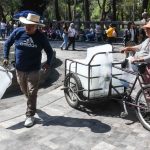The length of time a person can stand on one leg is a more telling measure of aging than changes in strength or gait, according to new research.
The study was carried out by a team led by Asghar Rezaei, from the Mayo Clinic in Rochester, Minnesota, United States.
Walking efficiently, maintaining good balance and having sufficient muscle strength contribute significantly to the independence and well-being of people as they age. How these factors change, and at what rate, can help doctors develop programs to ensure healthy aging. Individually, people can practice their ability to balance without special equipment and work to maintain that skill over the years, as much as possible.
In this study, 40 healthy, independent people over the age of 50 underwent gait, balance, grip strength, and knee strength tests. Half of the participants were under 65 years of age; the other half were 65 years old or older.
In the balance tests, participants stood on force plates in different situations: with both feet with eyes open, with both feet with eyes closed, on the non-dominant leg with eyes open, and on the non-dominant leg with eyes open. dominant with eyes open. The tests lasted 30 seconds each.
Standing on one leg — specifically the non-dominant leg — showed the greatest rate of decline with age.
The results of the study indicate that if the person can stand on one leg for 30 seconds, they have good ability to maintain balance. If you don’t resist that long, you may be losing your faculties. (Photo: Amanda Mills/CDC)
“Balance is an important measure because, in addition to muscle strength, it requires input from vision, the vestibular system, and somatosensory systems,” explains D. Kenton Kaufman, co-author of the study and director of the Movement Analysis Laboratory at the Mayo Clinic. “Changes in balance are noticeable. If you have poor balance, you are at risk of falling whether you are moving or not. Falls represent a serious health risk with serious consequences.”
Unintentional falls are the main cause of injuries among those over 65 years of age. Most falls among the elderly are the result of a loss of balance.
In one of the tests, the researchers used a custom-made device to measure the participants’ grip. For the knee strength test, participants sat and were instructed to extend their knee as forcefully as possible. Both the grip strength and knee strength tests were on the dominant side. Grip strength and knee strength showed significant declines each decade, but not as much as balance. Grip strength decreased at a faster rate than knee strength, making it a better indicator of aging than other strength measures.
For the walking test, participants walked back and forth along an 8-meter level walkway at their own pace and speed. Gait parameters did not change with age. This was not a surprising result since the participants were walking at their normal pace, not their maximum pace, as Dr. Kaufman argues.
The researchers identified no differences between the sexes in the gait and balance tests, indicating that male and female individuals were equally affected by age.
The person can test their ability to balance by trying to stand on one leg for 30 seconds. This can also be a way to train your muscular and vestibular coordination to maintain correct balance. “If the person can stand on one leg for 30 seconds, they are doing well,” Kaufman says.
The study is titled “Age-related changes in gait, balance, and strength parameters: A cross-sectional study.” And it has been published in the academic journal PLoS ONE. (Source: Mayo Clinic)




![[Img #74662]](https://thelatestnews.world/wp-content/uploads/2024/12/Organisms-with-the-shortest-life-150x150.jpg)







![[Img #74341]](https://thelatestnews.world/wp-content/uploads/2024/11/What-standing-on-one-leg-can-tell-us.jpg)
![[Img #74662]](https://thelatestnews.world/wp-content/uploads/2024/12/Organisms-with-the-shortest-life-300x200.jpg)


Add Comment